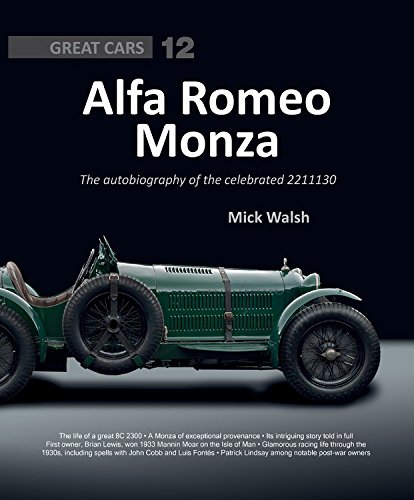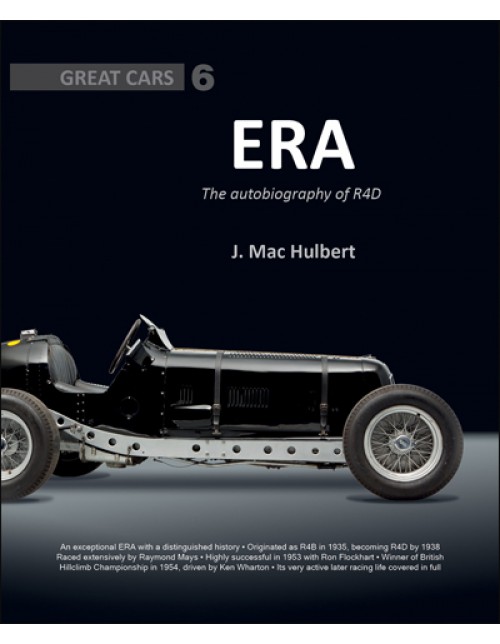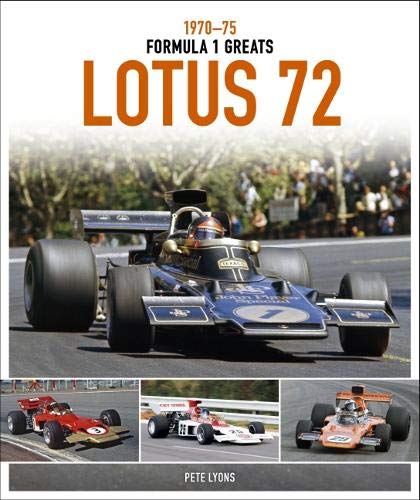
This book, the first in Evro’s new Formula 1 Greats series, covers one of the most revered Formula 1 cars ever made. Introduced in 1970, the wedge-shaped Lotus 72 competed for six seasons, winning 20 World Championship Grands Prix, two Drivers’ titles (for Jochen Rindt in 1970 and Emerson Fittipaldi in 1972) and three Constructors’ titles (in 1970, 1972 and 1973), racing first in Lotus’s evocative red, white and gold livery, then the equally eye-catching black and gold of the John Player Special period. Pete Lyons, Autosport’s renowned Formula 1 reporter for part of the Lotus 72 era, explores the car’s entire race-by-race career in his insightful commentary accompanying a magnificent array of more than 300 photos.
- The 1970 season: after troubled early development, the 72 finally took over from the long-serving 49, its four consecutive race wins enough to secure the World Championship for Jochen Rindt, posthumously after his death during practice for the Italian Grand Prix.
- The 1971 season: with promising youngster Emerson Fittipaldi elevated to team leader after Rindt’s death, great things were expected of the 72’s second season but it proved to be winless.
- The 1972 season: now in black and gold John Player livery, the 72 became far more competitive and Fittipaldi’s four Grand Prix victories made him World Champion.
- The 1973 season: Ronnie ‘SuperSwede’ Peterson joined Fittipaldi to form a dream team and together they won seven races, but because Lotus’s spoils were divided between the two drivers Jackie Stewart was able to come through to become World Champion.
- The 1974 season: still the 72 soldiered on, now as the fall-back car after its successor, the 76, failed to deliver; partnered by Jacky Ickx, Peterson won three Grands Prix.
- The 1975 season: well beyond its sell-by date, the 72 did a final season but by now it was far from effective, with Ickx’s second place in the tragic Spanish Grand Prix its best result.
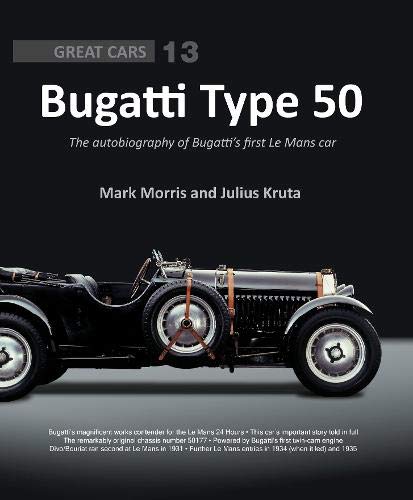
Launched in 1930, the Bugatti Type 50 heralded a new era with the introduction of the Molsheim marque’s first twin-cam design, a supercharged 4.9-litre straight-eight engine of prodigious power. At a time when brute force was needed to win the Le Mans 24 Hours, a competition version was developed and three such Type 50s took part in 1931. The car around which this book is focused, 50177, was leading the famous endurance race when the team withdrew it owing to tyre failures that had afflicted the sister cars, causing one to crash heavily at high speed.
The fascinating story of 50177, and the Type 50 in general, is told in this brilliantly researched and superbly illustrated book in the Great Cars series. Introductory chapters explain the economically perilous world of 1931, the genius of Ettore and Jean Bugatti, the bloodline of large-capacity Bugatti engines, and the Type 46 from which the Type 50 was derived. There follows an in-depth exploration of the Type 50’s design and development, including the Miller inspiration behind its twin-cam engine.
The four Le Mans races in which Type 50s took part form the core of the book and tell a story of promise unfulfilled. The subject car, 50177, raced three times, in 1931 as a works entry with race no. 5 (driven by Albert Divo and Guy Bouriat) and in 1934 and 1935 with works assistance as no. 2 (driven by Pierre Veyron and Roger Labric). A section about the drivers presents illustrated biographies of the four men who raced 50177 as well as the four others in the 1931 works team — Louis Chiron and Achille Varzi in no. 4 and Maurice Rost and Count Caberto Conelli in no. 6. Post-war, three-time Le Mans winner Luigi Chinetti bought 50177 in 1949 and took it to America, where it spent nearly 50 years with five different owners. The last of them was Miles Coverdale, a passionate Bugatti collector who kept the car for 23 years and uncovered much of its history through correspondence with former works mechanics, notably Robert Aumaître.
Co-authors Mark Morris and Julius Kruta, wellknown in the Bugatti world for their immense knowledge and enthusiasm, present a wealth of fresh information and illustration in this fine book.

This beautifully designed and illustrated essential guide to the Tour de France from Motorbooks’ Speed Read series will make you an instant expert on its history, its winners and rivalries, the tactics necessary to win it, and the technology of its bicycles.
Le Tour has sometimes been called “chess on wheels” because of the complicated strategies used by the race’s 22 teams and 176 riders. This book—written by award-winning cycling journalist John Wilcockson, who has covered the Tour 45 times—will help you understand those tactics, along with informing you about the race’s century-plus history, its famed winners and rivalries, and the technology that has gone into creating the modern racing bicycle and determining how today’s athletes train.
Among the questions answered are:
- Who owns the Tour?
- How are the course’s 21 stages selected?
- What are the most famous mountain climbs?
- How is the overall winner determined?
- What is a peloton, a soigneur, or an echelon?
- How big are the prizes?
- What are time bonuses?
- Who was the first American to compete in the Tour, and who was the first one to win it?
- How fast do the racers go down mountain descents?
- What speeds can the riders reach in sprint finishes?
- Why are the teams known by the names of their sponsors and not their countries?
- What do the riders eat, and where do they sleep every night?
- What are all those motorcycles doing among the cyclists?
- How do the organizers deal with doping scandals?
- And is it true that, one year, the top four finishers were all disqualified?
You will find the answers to all these questions, and many more, in this informative, beautifully illustrated, fun-to-read book: Speed Read Tour de France.
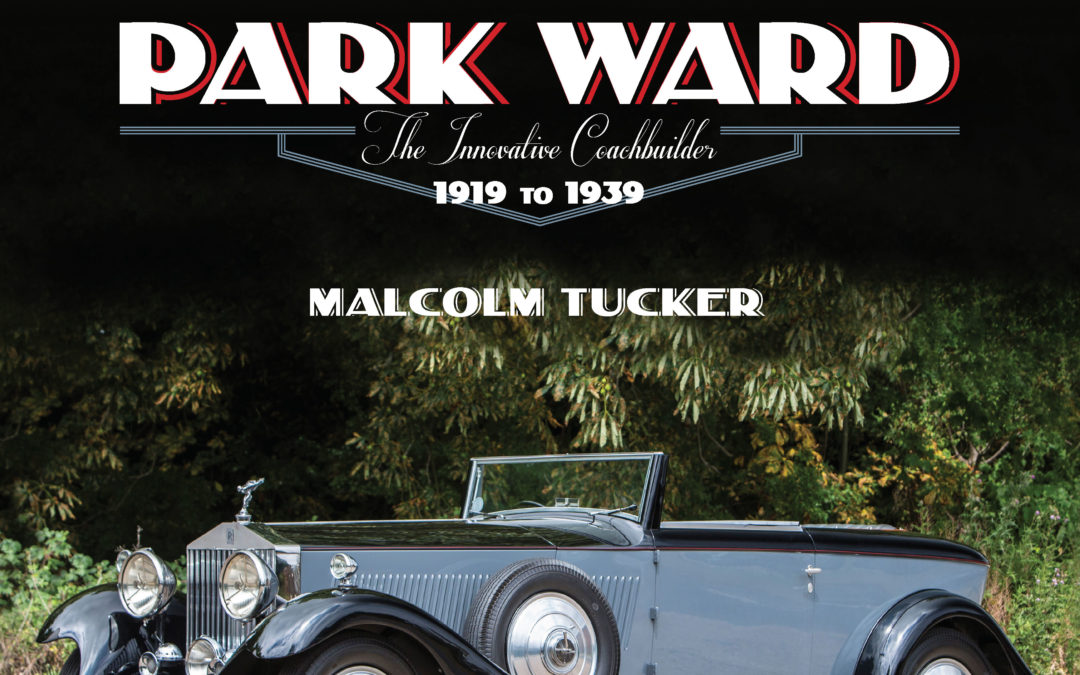
A major three-volume work on the pre-war history and cars of the great British coachbuilder, Park Ward. The company was the most prolific coachbuilder on Rolls-Royce and Bentley chassis, ultimately completing over 4,300 cars. Volume I and II is the story of Park Ward & Co Ltd. – the men who worked there and the company’s growing relationship with Rolls-Royce Ltd. A photographic record of all the Rolls-Royce models from Silver Ghost to the Wraith that carried Park Ward coachwork is included, along with chapters on the W. O. Bentley cars, and the Rolls-Royce and Bentley experimental cars with Park Ward coachwork. The Derby-built Bentleys follow, supported by chapters on the London Motor Show cars, coachwork on marques other than Rolls-Royce and Bentley, and examples of Park Ward advertising literature and catalogues. An appendix contains a series of articles written by ‘Bill’ Ward, the company founder’s son, entitled ‘The Art and Evolution of Coachbuilding’. Volume III contains extensive tables detailing each of over 3,000 pre-war Park Ward-bodied Rolls-Royce and Bentley, as well as a listing of over 1,000 Park Ward bodies on other marques. In addition, and rarely seen before, there are over 700 sales order pages extracted from Park Ward’s Finishing books.
Author Malcolm Tucker is a past-Chairman of the Rolls-Royce Enthusiasts’ Club, and is an established Rolls-Royce and Bentley historian, writer and ‘after dinner’ speaker. This will be his fourth book for Dalton Watson Fine Books. Malcolm has owned thirty-five Rolls-Royce or Bentley cars, including, for forty-six years, a 1928 20hp faux cabriolet by Park Ward.

“This generation of Americans has a rendezvous with destiny,” said President Franklin D. Roosevelt of the young Americans who grew up during the deprivation of the Great Depression and later served during World War II. The 23 described in this book went on to make their mark on the racetrack.
Ken Miles and Vasek Polak were not Americans during the war but later went on to become citizens. Carroll Shelby was not only a great driver but also created cars that are still manufactured. John Von Neumann and Vasek Polak were instrumental in helping to establish Porsche as a marque in the U.S. John Fitch, Ed Hugus, Chuck Daigh, Bill Stroppe, Max Balchowsky, Jay Chamberlain, Jim Peterson and Paul Newman were heroes in the war before succeeding in businesses and motorsports.
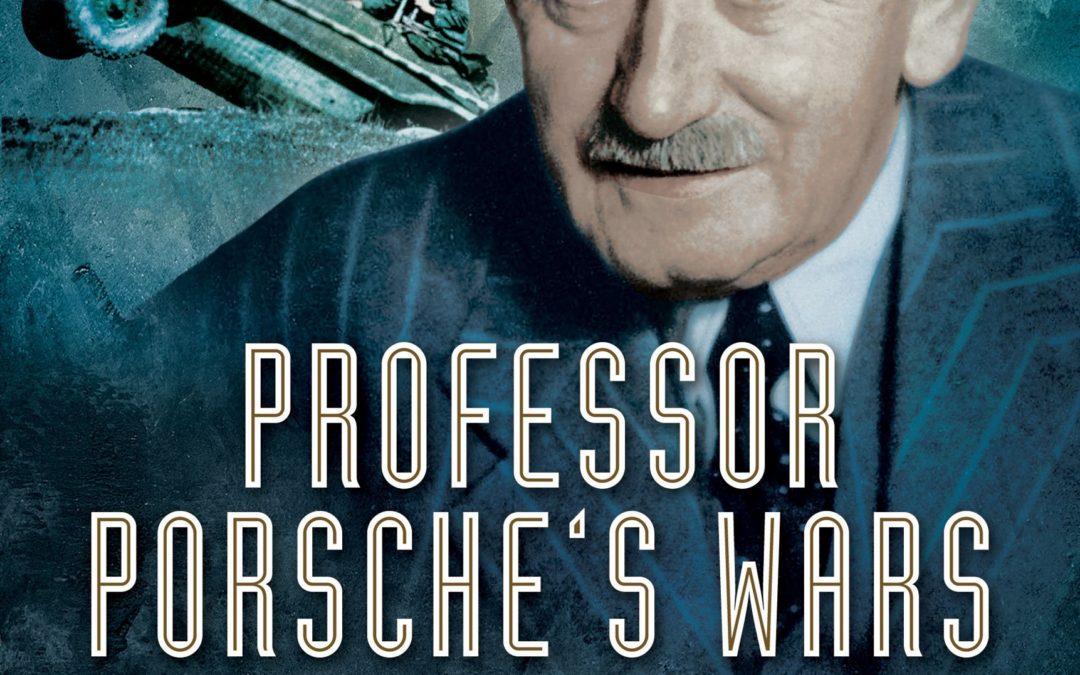
Regarded as one of the great automotive engineers of the twentieth century, Ferdinand Porsche is well remembered today for his remarkable automotive designs including the Volkswagen Beetle and Auto Union Grand Prix cars. Yet there is another side to his extraordinary career, for he was an equally inventive designer of military vehicles and machinery. In this field too he excelled. Indeed the sheer versatility of his contribution is astonishing. Karl Ludvigsen’s study is the definitive guide.
He tells the complete story, focusing on Porsche’s relations with the German armed forces and on the stream of advanced designs he was responsible for. Included are Austro Daimler’s pioneering aero engines, the Kübelwagen, Schwimmwagen, Type 100 Leopard tank, Ferdinand or Elefant tank destroyer and the astounding Type 205 Maus tank. He also describes Porsche’s creative work on aero engines, tank engines and even a turbojet for the V-1 flying bomb.
Karl Ludvigsen’s account confirms the preeminence of Ferdinand Porsche as a brilliant and prolific engineer, one of the most remarkable of his generation.

Trace the evolution of the supercar through the technology that drives it.
In The Science of Supercars, the authors describe the history of supercars, unraveling the mysteries and mechanics of the cars that changed the automotive world forever. In-depth interviews with the top names in the supercar and racing industries reveal their opinions on today’s supercars and their visions for the future.
David Coulthard, runner-up in the 2001 Formula One World Drivers’ Championship, provides the introduction. The authors follow with comprehensive chapters of inside information and exciting photographs that will be a catalog for supercar shoppers and a dream diary for others. The images show the interiors and exteriors of supercars and illustrated insets explain the technology.
-
1. The Thirst for Power – The internal combustion engine and the early days of speed
2. Style Versus Substance – Next steps, and the birth of aerodynamics
3. Emerging Technologies – The mechanics of war drive the birth of the supercar
4. Configuration – The Miura, the E-Type and the dawn of the modern age
5. The Science of Theater – Fashion and styling take center stage
6. The Turbo Years – The Porsche Turbo and the rebirth of supercar science
7. All-Wheel drive – Power or technology: how designers keep the cars on the road
8. Composites – The McLaren F1 and its technological legacy
9. Emerging Aero – Understanding the complex art of aerodynamics
10. Going to the Opera – The remarkable science behind the era-defining Bugatti Veyron
11. The Holy Trinity – Hybrid tech ushers in a new kind of supercar
12. The Future – The technology on the verge of reshaping the landscape.The Science of Supercars includes interviews with three of the top figures in the supercar world: Adrian Newey, legendary British Formula One engineer; Dr. Wolfgang Schrieber, Chief Engineer of the Bugatti Veyron; and Gordon Murray, designer of the McLaren F1 supercar, as well as contributions from iconic supercar manufacturers that include Lamborghini, Porsche, Bugatti, Pagani and McLaren.
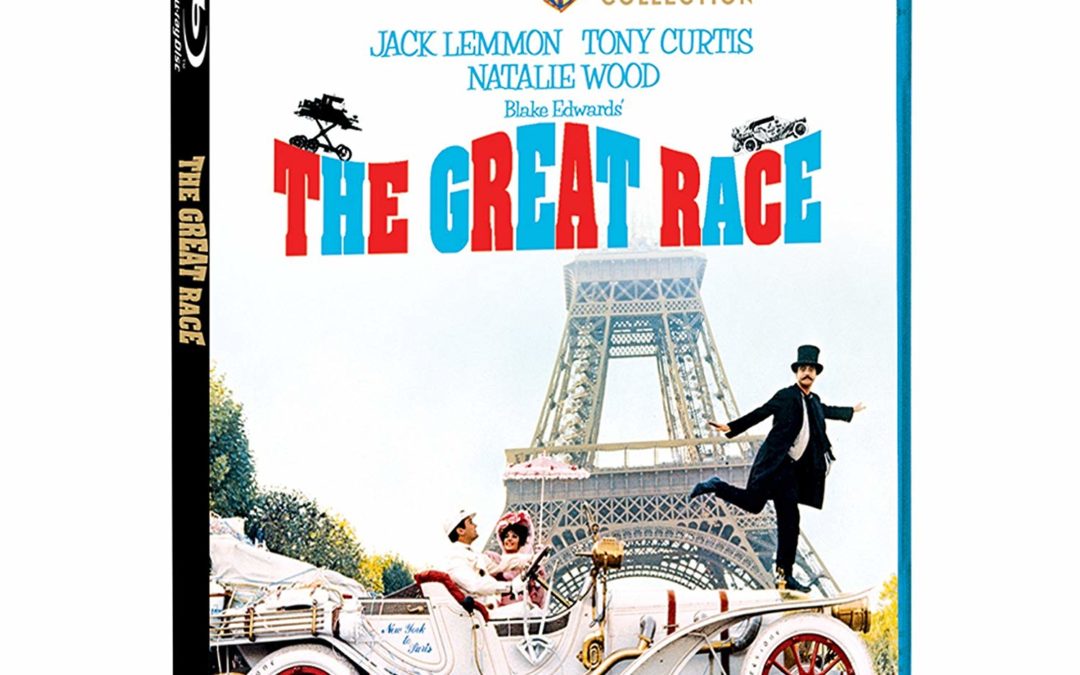
Tony Curtis stars as The Great Leslie, a hero among heroes whose purity of heart is manifested by his spotlessly white wardrobe. Leslie’s great rival, played by Jack Lemmon, is Professor Fate, a scowling, mustachioed, top-hatted, black-garbed villain. Long envious of Leslie’s record-setting accomplishments with airships and sea craft, Professor Fate schemes to win a 22,000-mile auto race from New York City to Paris by whatever insidious means possible. The problem is that Fate is his own worst enemy: each of his plans to remove Leslie from the running (and from the face of the earth) backfires. Leslie’s own cross to bear is suffragette Maggie Dubois (Natalie Wood), who also hopes to win the contest and thus strike a blow for feminism. The race takes all three contestants to the Wild West, the frozen wastes of Alaska, and, in the longest sequence, the mythical European kingdom of Carpania. This last-named country is the setting for a wild Prisoner of Zenda spoof involving Professor Fate and his look-alike, the foppish Carpanian king. When Leslie and Fate approach the finish line at the Eiffel Tower, Leslie deliberately loses to prove his love for Maggie. Professor Fate cannot stand winning under these circumstances, thus he demands that he and Leslie race back to New York.
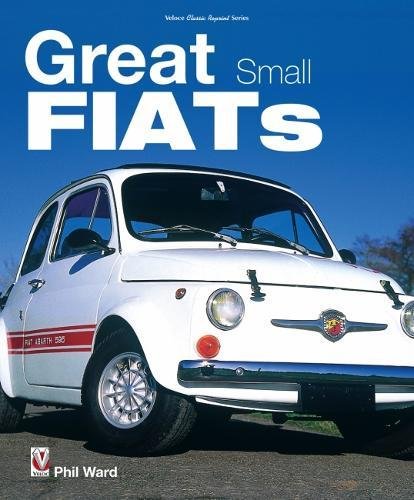
Great Small Fiats is a tribute to some of the best small Fiats ever produced.
In deciding which models to include in this book, Phil Ward concentrated on three criteria – greatness, size and emotion. Where size is an easy parameter to qualify, greatness is more complicated because it is a combination of of both the manufacturer’s and the public’s opinion. A car that is highly regarded by the public may not have been a commercial success and vice versa. A truly great car is one that works well for both parties. Emotion may be considered to be an element of greatness in that the public’s ‘love’ for a car is a fantastic benefit for a manufacturer and must be treasured. Fiat have made the mistake of ‘improving’ an icon on several occasions only to find that public opinion went against them. Fortunately Fiat has been magnanimous enough to respond by giving the car-buying public more of what it wants. As long as they continue to do so then Fiat’s reputation as the world’s greatest small car manufacturer is set to continue.
The author chose the Topolino as the starting point, as it fulfils all the criteria, and was the first Fiat built in the late 1930s to satisfy the Italian public’s new-found desire for mobilisation. The old conventions of car production were turned upside down with the arrival of the 600 which revolutionised car production techniques and maximised on passenger space and performance at minimal cost. These principles continued via a succession of models which include the 500, 850, 126, 127 through to more recent models like the Cinquecento and Seicento.
Running in parallel with these “cheeky” Fiats, this book covers a range of slightly larger cars that were built in huge numbers. Though rather staid in appearance, the 1950s Millecento was family transport for millions of Italians covering three decades, four when the Indian-built cars are included. Similarly the 128, Panda and Uno were ‘the’ Italian small cars of the ’70s, ’80s and ’90s. Nuova Panda carries the banner through to recent models.
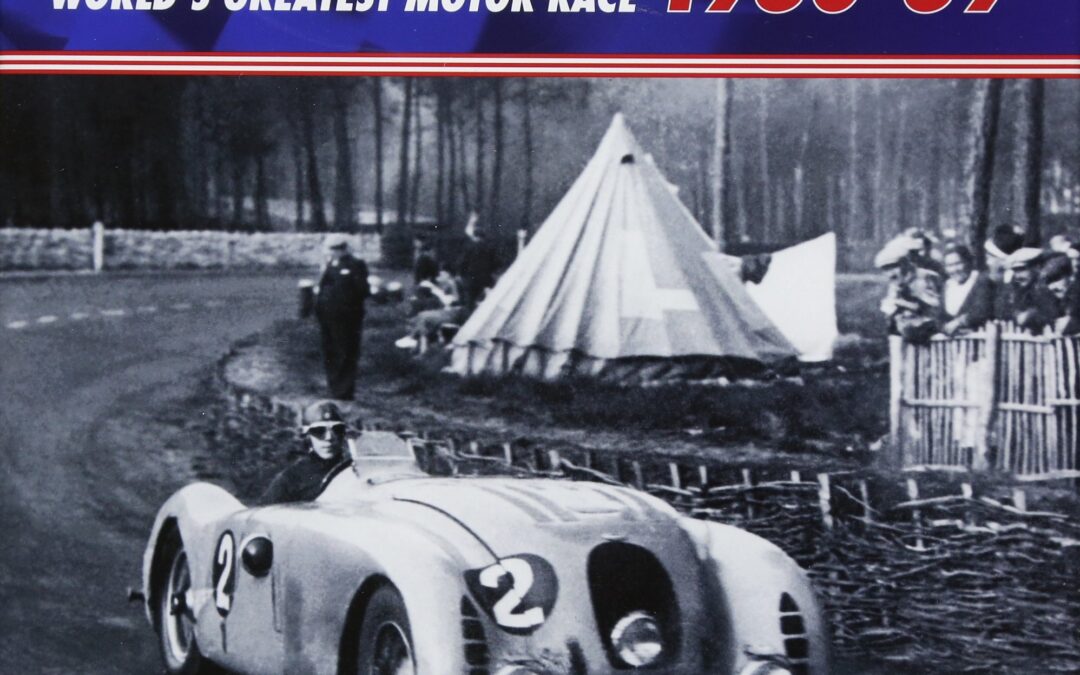
Officially licensed with the ACO, the organisers of the annual Le Mans 24 Hours race, this sumptuous book is the seventh title in this decade-by-decade series and completes coverage of the endurance classic from its very beginning to the end of the 20th century. This title covers the nine races of the 1930s (no race was held in 1936) in which honours were divided between Italian, French and British manufacturers. Each race is exhaustively covered in vivid photographs, an insightful commentary providing more detailed information than has ever been published about the period, and full statistics. Compiled by an acknowledged authority of this legendary race, this series of books is treasured by all enthusiasts of sports car racing.
In the 1930 race Bentley achieved its fourth consecutive success, Woolf Barnato and Glen Kidston the winning drivers in the very same ‘Speed Six’ with which they had won in 1929.
Two of Britain’s greats of the era, Earl Howe and Henry Birkin, won for Alfa Romeo in 1931, beginning a four-race victory streak for the Italian manufacturer.
Tazio Nuvolari, the outstanding Grand Prix ace of the pre-war decade, secured an intensely dramatic last-lap victory in 1933 in the closest Le Mans finish to date.
Lagonda (1935) and Delahaye (1938) secured a win each, while Bugatti took two with the great Jean-Pierre Wimille driving its innovative Type 57 ‘Tank’ cars, with all-enclosing bodywork.
Highly detailed year-by-year treatment of the decade’s nine races, giving unprecedented depth of information and photographic coverage for each year.
Official status provides a number of unique features, including the reproduction of photographs and full-colour race poster artwork from the ACO’s archives.Complete data for each year includes technical regulations, entry list, circuit changes (with diagram), full results and category awards.
The whole work is beautifully designed and presented.

This rakish fighter became known as the ‘mount of aces’, being the type on which the most successful fighter pilots of Britain and her Empire went to war throughout the last 18 months of World War 1. It was the Spitfire of the Western Front: delivering greater speed, range, firepower and all-round performance than the vast majority of its opposition. Often working in partnership with the more pugnacious Sopwith Camel, the S.E.5 and S.E.5a ensured that no enemy aircraft was safe even a long way behind their own lines as the Royal Flying Corps gradually won air superiority over the trenches.
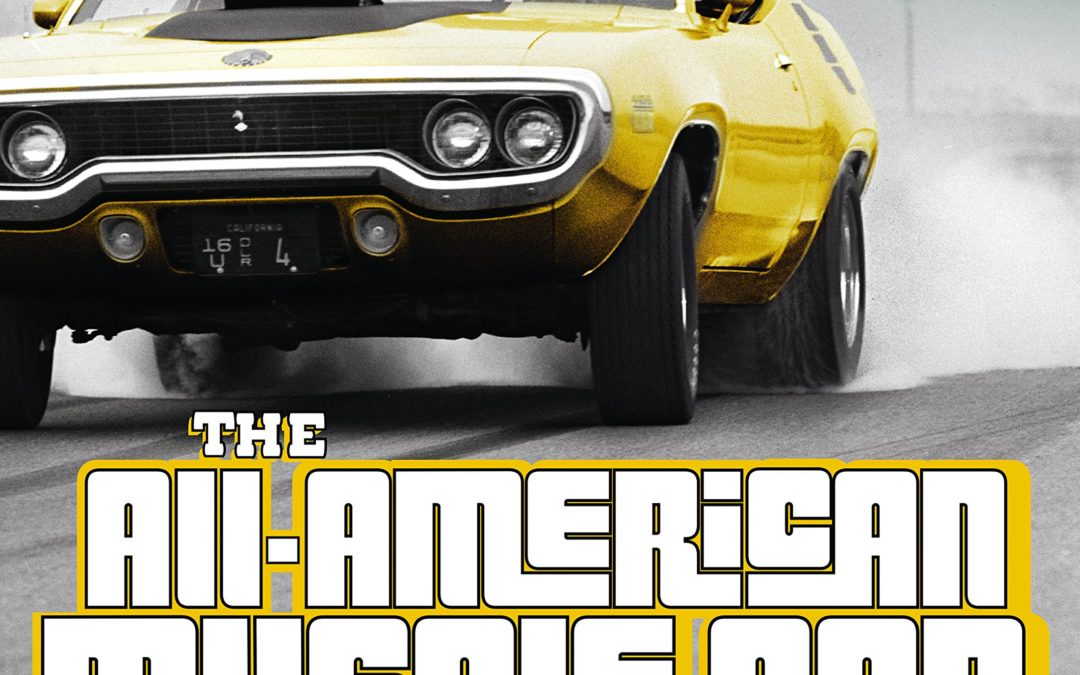
When John Z. DeLorean and his cadre of enthusiastic rule benders took it upon themselves to bolt Pontiac’s hottest engine into a mid-sized Tempest, disobeying orders from the top of General Motors food chain, they created something that should not have been, and will never be again: the muscle car. The resulting GTO spearheaded a new breed of performance car aimed at a new breed of buyer: the baby boom generation, tens of millions of young customers entering the market each year.
The All-American Muscle Car: The Rise, Fall and Resurrection of Detroit’s Greatest Performance Cars tells the story of these brutal performance machines through the words of muscle-car icons like Jim Wangers, the man who marketed DeLorean’s thuggish invention, Joe Oldham, a legendary automotive journalist who tested these cars when they first came off the production line, often via illegal street racing, and classic-car broker Colin Comer, who has been instrumental in restoring some of the most iconic (and valuable) muscle cars.
Top muscle car experts like Randy Leffingwell and David Newhardt tell other facets of the muscle-car story, like the pony-car wars between the Mustang, Camaro, ‘Cuda, and Challenger; the ultra-high performance dealer specials; and the rebirth of the modern muscle car. All told, this book provides the ultimate hands-on history of these most American of cars.
Soft Cover
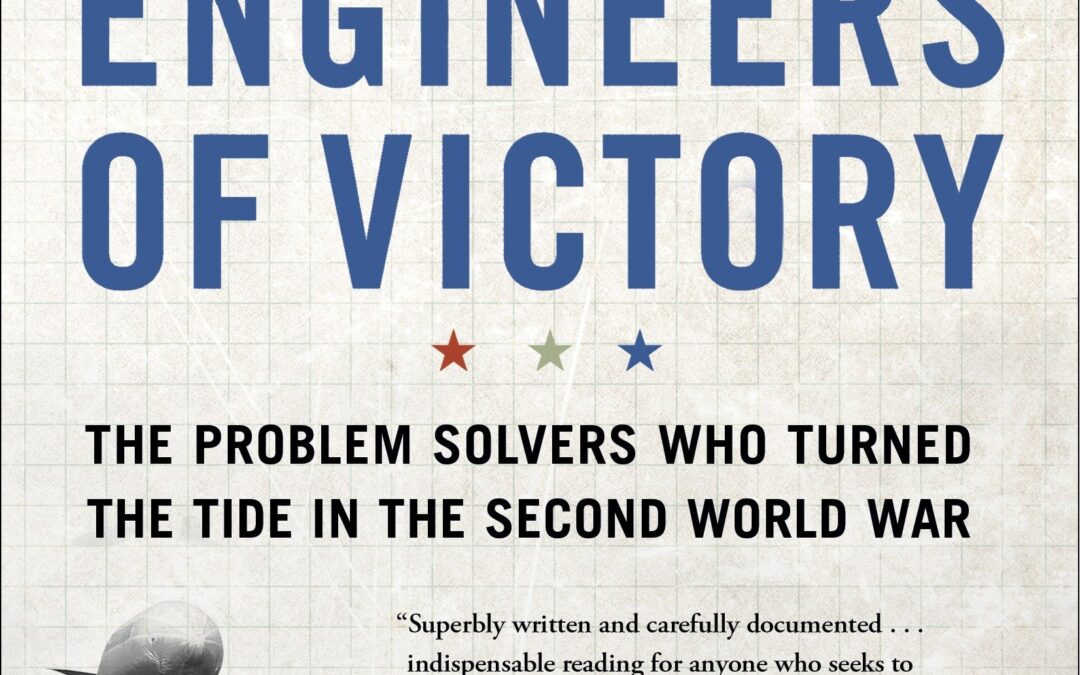
Paul Kennedy, award-winning author of The Rise and Fall of the Great Powers and one of today’s most renowned historians, now provides a new and unique look at how World War II was won. Engineers of Victory is a fascinating nuts-and-bolts account of the strategic factors that led to Allied victory. Kennedy reveals how the leaders’ grand strategy was carried out by the ordinary soldiers, scientists, engineers, and businessmen responsible for realizing their commanders’ visions of success.
In January 1943, FDR and Churchill convened in Casablanca and established the Allied objectives for the war: to defeat the Nazi blitzkrieg; to control the Atlantic sea lanes and the air over western and central Europe; to take the fight to the European mainland; and to end Japan’s imperialism. Astonishingly, a little over a year later, these ambitious goals had nearly all been accomplished. With riveting, tactical detail, Engineers of Victory reveals how.
Kennedy recounts the inside stories of the invention of the cavity magnetron, a miniature radar “as small as a soup plate,” and the Hedgehog, a multi-headed grenade launcher that allowed the Allies to overcome the threat to their convoys crossing the Atlantic; the critical decision by engineers to install a super-charged Rolls-Royce engine in the P-51 Mustang, creating a fighter plane more powerful than the Luftwaffe’s; and the innovative use of pontoon bridges (made from rafts strung together) to help Russian troops cross rivers and elude the Nazi blitzkrieg. He takes readers behind the scenes, unveiling exactly how thousands of individual Allied planes and fighting ships were choreographed to collectively pull off the invasion of Normandy, and illuminating how crew chiefs perfected the high-flying and inaccessible B-29 Superfortress that would drop the atomic bombs on Japan.
The story of World War II is often told as a grand narrative, as if it were fought by supermen or decided by fate. Here Kennedy uncovers the real heroes of the war, highlighting for the first time the creative strategies, tactics, and organizational decisions that made the lofty Allied objectives into a successful reality. In an even more significant way, Engineers of Victory has another claim to our attention, for it restores “the middle level of war” to its rightful place in history.
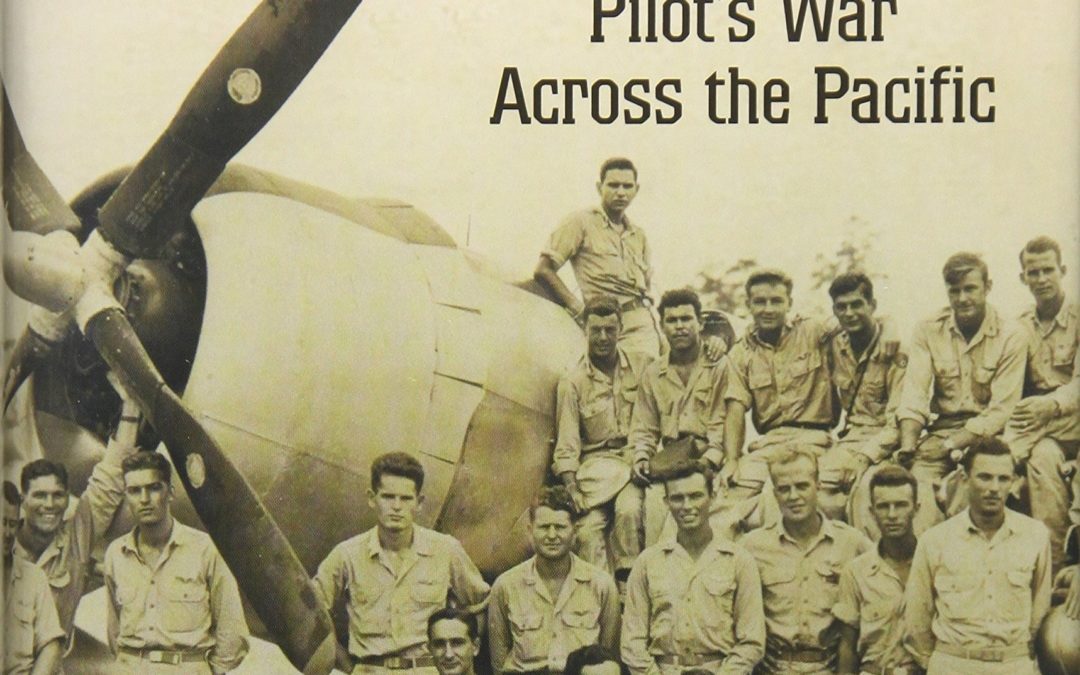
There were no mission limits for a pilot in the Pacific during World War II; unlike in Europe, you flew until it was time to go home. So it was for James “Jug” Curran, all the way from New Guinea to the Philippines with the 348th Fighter Group, the first P-47 Thunderbolt outfit in the Pacific.
After the attack on Pearl Harbor, Curran volunteered to try flying in the blue yonder, and trained as an Army fighter pilot. He got his wish to fly the P-47 in the Pacific, going into combat in August 1943, in New Guinea, and later helping start the “Black Rams” fighter squadron. The heavy U.S. Thunderbolts were at first curious to encounter the nimble, battle-hardened Japanese in aerial combat, but soon the American pilots gained skill of their own and their planes proved superior. Bombers on both sides could fall to fighters, but the fighters themselves were eyeball to eyeball, best man win.
Check Six! is an aviation chronicle that brings the reader into flight, then into the fight, throughout the Pacific War and back. This work, from someone who was there, captures the combat experience of our aviators in the Pacific, aided by pertinent excerpts from the official histories of units that “Jug” Curran flew with.
It is a tale of perseverance, as Curran flew over 200 combat missions, and with the men of the 348th Fighter Group proved the Thunderbolt’s great capability as they battled their way against a stubborn and deadly foe. This work increases the body of knowledge on the critical role of aviation in the Pacific War, as U.S. fighter pilots took the lead in our counteroffensive against the short-lived island Empire.

In the best-selling original book, Hot Rod Gallery: A Nostalgic Look at Hot Rodding’s Golden Years: 1930-1960, author and historian Pat Ganahl opened his archives and shared 192 pages and 350 photos of “some” of the most interesting and best photos of his collection. Filled with fascinating images of some of the coolest cars and builders, long-forgotten car clubs, and great shots of the dry lakes, nostalgia fans flocked to grab a piece of hot rodding history all in one convenient package. Well, if some is good, more is better, right?”
In Hot Rod Gallery II: More Great Photos and Stories from Hot Rodding’s Golden Years, Ganahl dug deeper into his massive archive for even cooler and more never-before-seen photos in both color and black and white to provide another album of great hot rodding photos. He was pleasantly surprised to find that he had more great stuff in old files and folders, hidden away for decades. In this edition are even more dry lakes shots, post-war rods, lead sleds, show circuit cars, and a chapter on marvelous mills. He even dug a little deeper into the early 1960s.
If you liked the first edition of Hot Rod Gallery by Pat Ganahl: A Nostalgic Look at Hot Rodding’s Golden Years: 1930-1960, you may like this one even more. Ganahl guarantees that it is filled with images you have never seen, and he offers his commentary and a lifetime of expertise in this selection of fantastic images from his expansive archive. You can spend hours looking at all the details and soaking in the history in these images, and we know you’ll enjoy this book as much as you did the first.
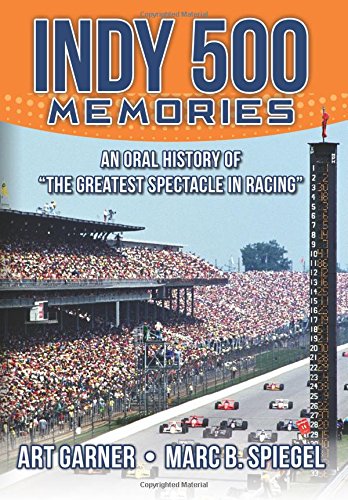
More than 150 drivers, fans, celebrities and others share their personal stories and remembrances of the world’s most famous auto race. Twenty different race winners representing more than 40 victories are among those sharing memories, including the greatest names in the sport: Foyt, Unser, Andretti, Rutherford, Cheever, Mears, Sullivan, Rahal, Montoya, Castroneves and Kanaan. Others include Gurney, Guthrie, Goodyear, Patrick, Power, Stewart, St. James and many more. The book is as much about dreams as it is memories, from A.J. Foyt listening to the 500 in his daddy’s garage as young boy, to Bev Patrick bursting into tears as her daughter, Danica, becomes the first woman to lead the 500. There is laughter and tears, triumph and tragedy, ranging from Evi Gurney hiding under a stack of sweaty driver uniforms in the back of a car so she can sneak into Gasoline Alley, to Indy’s darkest days in 1964 and 1973. The memories are full of surprises and unbridled honesty. “I felt like I was at the point of an arrow that was being hurled forward by a hurricane,” recalled Eddie Cheever. “It was so violent, to control it for 500 miles and finish a race, I thought would be a miracle.” Fans and family have always been an integral part of making the event “The Greatest Spectacle in Racing” and both are well represented in Indy 500 Memories. Whether the stories are about family traditions or secretly spreading a loved one’s ashes on the Speedway’s grounds, they are often as personal and interesting as those of the drivers. From the first memory by Mario Andretti, to the last one of Ryan Hunter-Reay, Indy 500 Memories is sure to invoke surprise, laughter, tears and awe and is a must read for any racing fan.
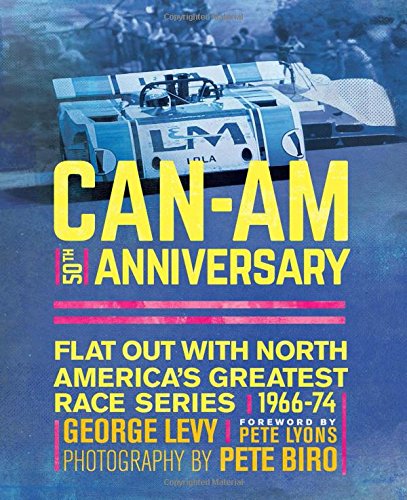
SOLD OUT
COLLECTOR’S LIMITED EDITION OF 300 SIGNED SLIPCASE BOOKS
Forget the rule book and relive one of the most exciting race series ever with Can-Am 50th Anniversary!
The first rule of Can-Am: There are no rules. Or at least damn few rules. The bodywork had to enclose the wheels and there had to be something that loosely resembled a passenger seat–if your passenger was a badly misshapen human or perhaps a lab monkey. Otherwise, set your racing mind free. No limits to engine options or output, no restrictions on aerodynamic aids or body shape. It was as close to unrestricted road racing as racing had ever gotten or would ever get again. And it was fantastic.
From its introduction in 1966 to the end of its classic period in 1974, North America’s Can-Am series was the most exciting, technologically advanced, and star-studded racing series of the day. Its essentially rules-free formula attracted everyone from crazed backyard engineers to specialists like McLaren, Chaparral, Shadow, and Lola to manufacturers like Ford, Ferrari, Chevrolet, and Porsche. Top drivers including Mario Andretti, Jackie Stewart, Parnelli Jones, Bruce McLaren, Denis Hulme, Dan Gurney, Phil Hill, Mark Donohue, Peter Revson, Jim Hall, Jody Scheckter, Chris Amon, George Follmer and John Surtees competed on tracks across the US and Canada taking time off from Formula One schedules and other duties to drive in Can-Am because the racing and the cars were so exciting.
Can-Am 50th Anniversary offers a heavily illustrated look back at what is arguably the greatest race series ever to grace the roadracing circuits of North America. Photographer Pete Biro was Goodyear Tire’s official photographer and followed the series throughout the entire run from 1966-’74. The vast majority of the book’s images are unpublished or long out of circulation. Biro brings his unique perspective and his close relationship with the drivers, team owners, and constructors to bear on the captions while former AutoWeek editor George Levy provides an exciting text reflecting the thrill of Can-Am racing.
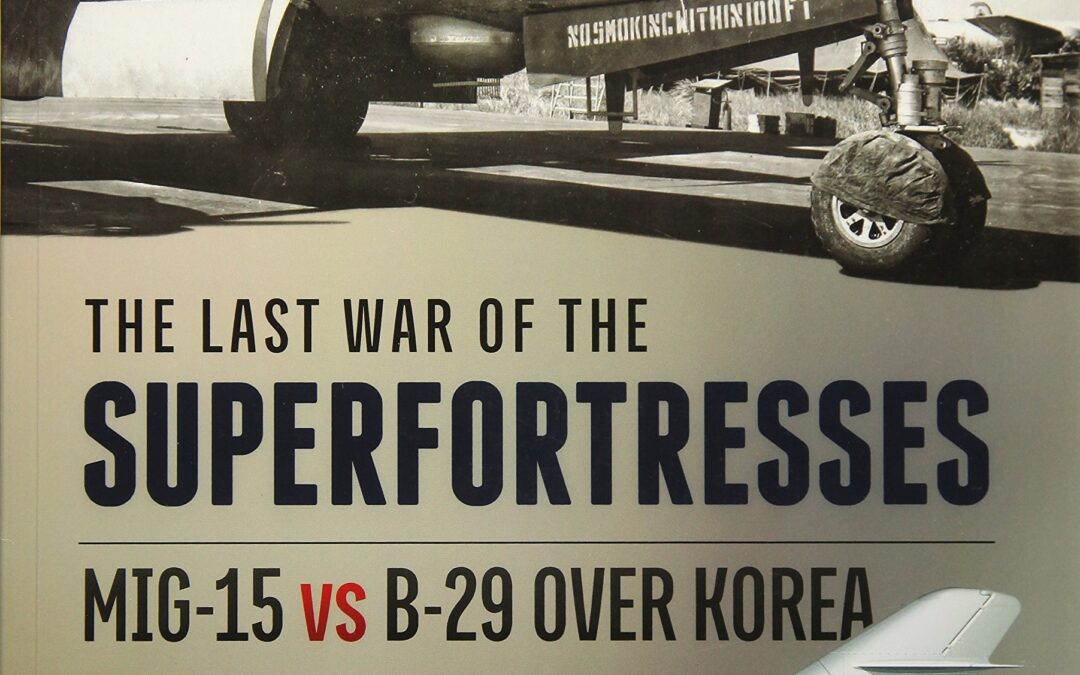
This work is an attempt by the authors to give as full and detailed a history as possible of the confrontation between Soviet fighters and the principal strike force of the United States Far East Air Force – the B-29 ‘Superfortress’ bombers during the course of the Korean War between 1950-1953. Military documents, which the authors have studied over many years of work in the Central Archive of the Ministry of Defense of the Russian Federation in Podolsk – as well as published Western sources – form the basis of this book.
The recollections of pilots who served in the 64th Fighter Air Corps, and who participated personally in the events described, are also widely used. Almost all the battles that took place between Soviet fighters and the ‘Superfortresses’ are analyzed in detail; the authors have, on the basis of a comparison of Soviet archive documents and data from published Western sources, attempted to clarify the actual losses on both sides in these battles. Particular attention has been paid to key events in the history of the confrontation between the MiG-15 and B-29 such as the air battles of April and October 1951, which had a significant impact on the course of the Korean War and influenced the development of military aviation in both the USSR and the USA. Following the encounters on the approaches to the bridges at Andung of 12 April 1951 Strategic Air Command decided against using ‘Superfortresses’ close to the area around the MiG bases. The outcome of a series of air battles from 22 to 27 October 1951 – the most famous of which was the battle between MiGs and B-29s in the area close to the airfield at Namsi on 23 October (‘Black Tuesday’) was a ban by Strategic Air Command on daylight operations by ‘Superfortresses’ in the Soviet fighter’s zone of operation. These battles also influenced the technical policy of the United States Air Force in relation to strategic bombers.
Extensive losses in combat with the MiGs served as one of the most influential arguments for curtailing the piston engine B-36 and B-50 bomber programs and boosting development of one of the most famous aircraft in the history of global aviation – the B-52 ‘Stratofortress’. Night operations, to which the B-29s and subsequently Soviet fighters were transferred, are also analyzed in detail in this book. These nocturnal operations culminated in the air battles of December 1952 and January 1953. After sustaining losses in these battles that were comparable to those of October 1951 the ‘Superfortresses’ would subsequently only carry out nocturnal sorties to the MiGs’ zone of operation in poor weather conditions. In this work, the authors have analyzed the advantages and the disadvantages of the La-11 and the MiG-15bis – the principal fighters of the 64th Fighter Air Corps – from the point of view of their ability to intercept the B-29s. Attention has been paid to the tactics of the opposing sides, and to how these changed over the course of the war. The technical aspects of the confrontation between Soviet fighters and ‘Superfortresses’ have been examined, and the reasons behind the different periods of success or failure in terms of performance in combat have been identified.
A great deal of statistical material has been provided in this book, which characterizes combat operations carried out by the B-29s and the fighters of the 64th Fighter Air Corps, both within the text itself and in the form of easy-to-use tables. The book is illustrated with photographs obtained both from the personal archives of veterans of the 64th Fighter Air Corps; from the Central Archive of the Ministry of Defense of the Russian Federation; and US National Archives. Color profiles showing camouflage & markings are also included.










